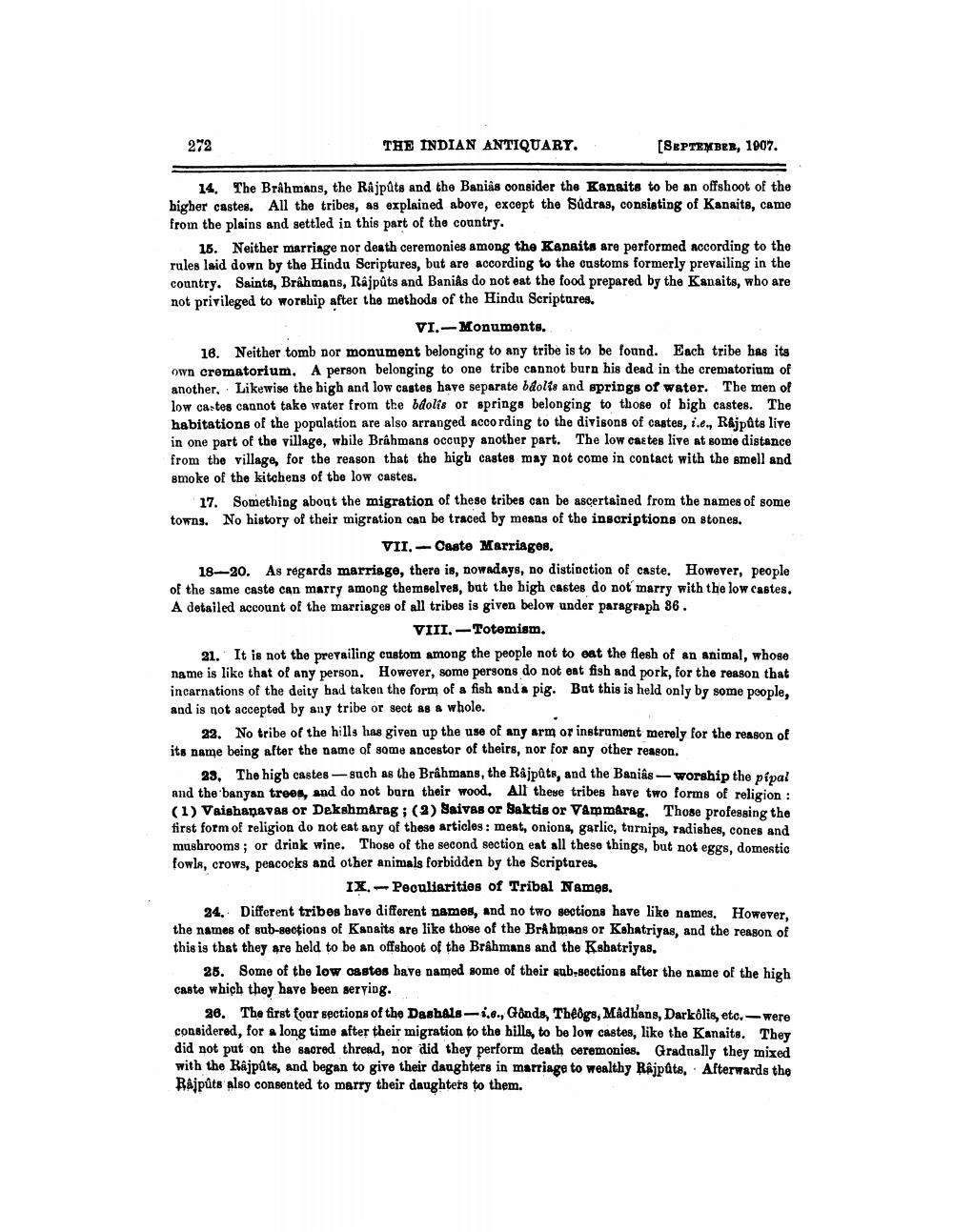________________
272
THE INDIAN ANTIQUARY.
[SEPTEMBER, 1907.
14. The Brahmans, the Râjpûts and the Baniâs consider the Kanaits to be an offshoot of the higher castes. All the tribes, as explained above, except the Sûdras, consisting of Kanaits, came from the plains and settled in this part of the country.
15. Neither marriage nor death ceremonies among the Kanaits are performed according to the rules laid down by the Hindu Scriptures, but are according to the customs formerly prevailing in the country. Saints, Brahmans, Rajpûts and Baniâs do not eat the food prepared by the Kanaits, who are not privileged to worship after the methods of the Hindu Scriptures.
VI.-Monuments.
16. Neither tomb nor monument belonging to any tribe is to be found. Each tribe has its own crematorium. A person belonging to one tribe cannot burn his dead in the crematorium of another, Likewise the high and low castes have separate bdolts and springs of water. The men of low castes cannot take water from the bdolis or springs belonging to those of high castes. The habitations of the population are also arranged according to the divisons of castes, i.e., Rajpûts live in one part of the village, while Brahmans occupy another part. The low castes live at some distance from the village, for the reason that the high castes may not come in contact with the smell and smoke of the kitchens of the low castes.
17. Something about the migration of these tribes can be ascertained from the names of some towns. No history of their migration can be traced by means of the inscriptions on stones.
VII. Caste Marriages.
18-20. As regards marriage, there is, nowadays, no distinction of caste. However, people of the same caste can marry among themselves, but the high castes do not marry with the low castes. A detailed account of the marriages of all tribes is given below under paragraph 36.
VIII.-Totemism.
21. It is not the prevailing custom among the people not to eat the flesh of an animal, whose name is like that of any person. However, some persons do not eat fish and pork, for the reason that incarnations of the deity had taken the form of a fish and a pig. But this is held only by some people, and is not accepted by any tribe or sect as a whole.
22. No tribe of the hills has given up the use of any arm or instrument merely for the reason of its name being after the name of some ancestor of theirs, nor for any other reason.
23. The high castes-such as the Brahmans, the Râjpûts, and the Baniâs-worship the pipal and the banyan trees, and do not burn their wood. All these tribes have two forms of religion: (1) Vaishanavas or Dekshmårag; (2) Saivas or Baktis or Vammarag. Those professing the first form of religion do not eat any of these articles: meat, onions, garlic, turnips, radishes, cones and mushrooms; or drink wine. Those of the second section eat all these things, but not eggs, domestic fowls, crows, peacocks and other animals forbidden by the Scriptures.
IX. Peculiarities of Tribal Names.
24. Different tribes have different names, and no two sections have like names. However, the names of sub-sections of Kanaits are like those of the Brahmans or Kshatriyas, and the reason of this is that they are held to be an offshoot of the Brahmans and the Kshatriyas,
25. Some of the low castes have named some of their sub-sections after the name of the high caste which they have been serving.
26. The first four sections of the Dashals-i.e., Gônds, Thêôgs, Madhans, Darkôlis, etc.—were considered, for a long time after their migration to the hills, to be low castes, like the Kanaits. They did not put on the sacred thread, nor did they perform death ceremonies. Gradually they mixed with the Rajputs, and began to give their daughters in marriage to wealthy Rajpûts, Afterwards the Rajpûts also consented to marry their daughters to them.




